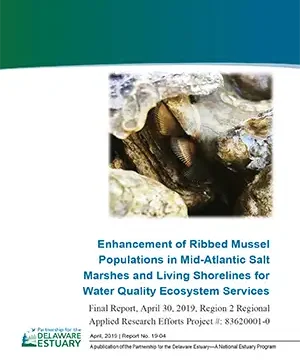Abstract or Summary

Historically, eroding shorelines have been managed through the implementation of hardened infrastructure such as seawalls, bulkheads, and revetments. As these structure are spatially static, they are unable to respond to changing environmental conditions and disrupt connectivity between adjacent habitats. Natural and nature-based approaches, including living shorelines, represent a suite of coastal protection design approaches to stabilize eroding shorelines, while increasing the net ecological uplift within the areas where they are applied. Many of the biotic components of coastal salt marshes provide important ecosystem services and are inextricably tied to the structural integrity and persistence of the marsh (e.g. vegetation and shellfish). These native species represent potential key components of living shorelines to facilitate ecosystem vitality. The ribbed mussel, Geukensia demissa, plays such a role. Ribbed mussels support vegetation production through the deposition of nutrient rich feces and pseudofeces; which, through additional root production, provides additional mussel habitat, creating a positive feedback loop. Additionally, mussels have been found to reduce salt marsh erosion where they exist in great densities through the development of their byssal threads, which bind to plant roots facilitating stabilizing sediments along the marsh edge. Due to their role in important ecological and structural salt marsh processes, ribbed mussels have been suggested as an important biotic component for living shorelines designs. This study was designed to investigate the effects of substrate protection and preference on ribbed mussel recruitment as they relate to materials commonly used in living shoreline installations in the Delaware Estuary.
A three-tiered study design was implemented in two representative river systems where living shorelines had been previously installed. First, ribbed mussel densities were quantified on previously deployed living shoreline materials and adjacent natural marsh. Second, to investigate the role of substrate protection on ribbed mussel recruitment and persistence, a field experiment was deployed in both river systems to assess recruitment on exposed vs. protected substrates at three positions relative to the natural marsh edge where living shoreline materials are commonly installed. Third, a field experiment was deployed in Nantuxent Creek to evaluate substrate preference on three commonly used living shoreline materials (coir fiber, oyster shell, and oyster castle material) deployed on recruitment tiles at three protection levels (covered by shell bag mesh, coir mesh mat, or not covered). Two rivers that are representative of the Delaware Estuary system were selected for this study, Maurice River in Commercial Township, New Jersey, and Nantuxent Creek in Downe Township, New Jersey. Both of these rivers are home to living shorelines constructed by Partnership for the Delaware Estuary (PDE). The two Maurice River living shorelines were installed in 2009 (D15) and 2010 (Matt’s Landing), while the Nantuxent Creek living shoreline was installed in 2014. Both sites had identical living shoreline designs, with coir log cusps lined with oyster shell bags along their waterward margins. Each living shoreline was planted with native S. alterniflora on the year of installation. Adjacent to these living shoreline treatments are paired controls with a natural S. alterniflora marsh edge. Results showed that on materials deployed for ~10 years, mean ribbed mussel density in shell bags was significantly higher ( =1,771±185 m-2) than on the natural marsh edge ( =0±0 m-2) and on coir logs ( =30±18 m-2), which did not significantly differ from each other. Generally, ribbed mussel recruitment was significantly higher on the top surface of shell bags with the surface mesh left intact, than on shell bags where the shell bag mesh was cut to expose the top surface of the oyster shell. However, ribbed mussel surface recruitment was only between 0.5-7.0% of total bag recruitment, and there were no significant differences in total bag recruitment between bags with exposed and unexposed surfaces. Mean ribbed mussel recruitment was significantly greater on recruitment tiles protected by shell bag mesh ( =1.74±0.36 tile-1) than on tiles protected by coir fiber ( =0.40±0.17 tile-1, p<0.004) or not protected at all ( =0.75±0.25 tile-1, p<0.02), which did not differ significantly from each other (p>0.70 tile-1). Ribbed mussel recruitment on coir fiber and oyster castle substrates were 163% and 42% of the recruitment that occurred on oyster shell and as such, filtration rate estimates were greatest on oyster castle substrate (503.44 mg h-1 ft-1), lowest on coir fiber substrate (129.72 mg h-1 ft-1), and median on oyster shell substrate (308.86 mg h-1 ft-1). When living shorelines are newly installed, they are characterized by large expanses of unprotected mudflat surface area. Ribbed mussels have been shown to facilitate growth of vegetation (Bertness 1984), so improving recruitment of these animals to living shorelines can aid in the migration of plants into barren unprotected areas behind shoreline installations.
The results from this study identify a relationship between interstitial spaces and ribbed mussel recruitment, as has been shown with oysters. Therefore, maximizing interstitial space within living shoreline materials can help to create the habitat niche needed for population establishment. A key question regarding population development for ribbed mussels is what mechanisms can support populations from younger, more vulnerable, individuals to persist through time. The results from this study indicate that the refuge provided by interstitial space facilitated recruitment, but also that some degree of substrate protection also provided value. Therefore, the incorporation of substrates that are either protected by materials that allow for juvenile mussel passage, such as a ridged mesh that resists sediment collection, or are three-dimensionally robust, with a surface layer providing protection to the interior, will improve the efficacy of ribbed mussel recruitment. Substrate protection material should also have spaces that are large enough to enable the uninhibited passage of ribbed mussel larvae and sediment, to avoid any “clogging” of recruitment paths.